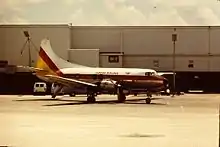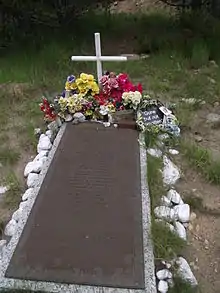Wichita State University football team plane crash
In clear and calm weather in Colorado at 1:14 p.m. MDT on Friday, October 2, 1970, a chartered Martin 4-0-4 airliner crashed into a mountain eight miles (13 km) west of Silver Plume.[1][2][3][4] Operated by Golden Eagle Aviation, the twin-engined propliner carried 37 passengers and a crew of three; 29 were killed at the scene and two later died of their injuries while under medical care.[5]
 A Martin 4-0-4, circa 1981, in Florida Airlines livery. | |
| Accident | |
|---|---|
| Date | October 2, 1970 |
| Summary | Controlled flight into terrain due to pilot error |
| Site | Clear Creek County, Colorado 8 miles (13 km) west of Silver Plume, near the Loveland Ski Area 39°41′36″N 105°52′57″W |
| Aircraft type | Martin 4-0-4 |
| Operator | Golden Eagle Aviation |
| Registration | N464M, ex-N460A |
| Flight origin | Wichita Mid-Continent Airport |
| Stopover | Stapleton International Airport |
| Destination | Logan-Cache Airport |
| Occupants | 40 |
| Passengers | 37 |
| Crew | 3 |
| Fatalities | 31 |
| Injuries | 9 |
| Survivors | 9 |

It was one of two aircraft carrying the 1970 Wichita State Shockers football team to Logan, Utah, for a game against Utah State;[6] the second aircraft flew a conventional route and arrived safely in Utah. Pilot errors, including poor in-flight decisions and inadequate pre-flight planning, were officially reported as leading to the crash.[7]
Background
About three months before the crash, Wichita State contracted Golden Eagle Aviation to supply a Douglas DC-6B, to fly the team to away games for the 1970 season.[6] The four-engined DC-6 was a large, powerful aircraft that could accommodate the entire team. Golden Eagle Aviation did not own the DC-6, but had an arrangement with the Jack Richards Aircraft Company to use it.[6] After the agreements were made, the DC-6 was damaged and was unavailable for use.[6] A pair of Martin 4-0-4s (which had not flown since 1967) were re-certified for flight. On October 2, 1970, these were ferried from the Jack Richards Aircraft Company facilities in Oklahoma City to Wichita, instead of the DC-6.[7]
Initial leg
Upon arrival in Wichita, the two aircraft were loaded with luggage and the passengers were boarded. They took off and headed west to a refueling stopover in Denver at Stapleton Airport; from there they would continue to Logan Airport in northern Utah.[8]
The two aircraft were dubbed "Gold" and "Black" after the school colors.[6] "Gold", the aircraft that later crashed, carried the starting players, head coach, and athletic director, as well as their wives, other administrators, boosters, and family. The designated "Black" plane transported the reserve players, assistant coaches, and other support personnel.[9]
The President of Golden Eagle Aviation, Ronald G. Skipper (1936–2003),[10] was the pilot flying "Gold."[4] Although occupying the left seat, he was acting in the capacity of a First Officer because he did not have a type rating on the Martin 4-0-4.[7] During the flight to Denver he visited passengers in the cabin, advising them that after refueling they would take a scenic route, near Loveland Ski Area and Mount Sniktau, the proposed alpine skiing venues for the 1976 Winter Olympics, recently awarded to Denver in May. The other crew flying the "Black" aircraft adhered to the original flight plan and took a more northerly route, heading north from Denver to southern Wyoming then west, using a designated airway. Less scenic, this route allowed more time to gain altitude for the climb over the Rocky Mountains.[4][7]
Accident sequence
While the aircraft were refueled and serviced in Denver, First Officer Skipper purchased aeronautical sectional charts for the contemplated scenic route.[8] The National Transportation Safety Board (NTSB) investigation report stated the First Officer testified that he intended to use the charts to help point out landmarks and objects of interest to the passengers. The report concluded the crew did not allow enough time for the charts to be studied properly to avoid high terrain before takeoff commenced.[7] After takeoff in clear weather, the two aircraft took divergent paths away from Denver.[7]
Shortly before the crash, several witnesses described seeing an aircraft flying unusually low towards the Continental Divide. Some witnesses located on higher mountainside locations, such as Loveland Pass at 11,990 feet (3,655 m), reported seeing it flying below them.[7] Crash survivor Rick Stephens was a senior guard and stated in 2013, "...as we flew along over I-70, that there were old mines and old vehicles above us. I noticed we were quite a bit below the top of the mountains. I got up to go to the cockpit, which wasn't unusual to do, and I could tell we were in trouble, looking out the window and seeing nothing but green in front of us."[11]
The overloaded aircraft,[12][13] nearing Loveland Pass as it flew up Clear Creek Valley, became trapped in a box canyon and was unable to climb above the mountain ridges surrounding it on three sides, nor complete a reversal turn away from the sharply rising terrain.[4] At 1:14 p.m. MDT, the "Gold" aircraft struck trees on the east slope of Mount Trelease, 1,600 feet (490 m) below its summit, and crashed. The NTSB report stated a belief that many on board survived the initial impact, based on the testimony of survivors and rescuers.[4][7] The load of fuel on board did not explode immediately, allowing survivors to escape the wreckage, but the passenger cabin was eventually consumed by an explosion before those still alive and trapped inside could escape.
Of the total of 40 on board, the death count at the scene was 29, which included 27 passengers, the captain, and flight attendant. One of the deceased passengers was an off-duty flight attendant who was assisting. Two of the initial 11 survivors later died of their injuries to bring the total dead to 31,[7] 14 of whom were Wichita State football players.[11] First to arrive at the crash scene were construction workers from the nearby Eisenhower Tunnel project and motorists on U.S. 6 (I-70).[14] The first officer (company president) survived; he was flying the plane from the left seat.
Probable cause
The National Transportation Safety Board report states that weather played no role in the accident,[7] and lists the probable cause to be that the pilot made improper decisions in-flight or in planning:
"The intentional operation of the aircraft over a mountain valley route at an altitude from which the aircraft could neither climb over the obstructing terrain ahead, nor execute a successful course reversal. Significant factors were the overloaded condition of the aircraft, the virtual absence of flight planning for the chosen route of flight from Denver to Logan, a lack of understanding on the part of the crew of the performance capabilities and limitations of the aircraft, and the lack of operational management to monitor and appropriately control the actions of the flightcrew."[7][8]
Aftermath
The USU president, vice president, provost, athletic director, and athletic information officer were all unavailable in the immediate aftermath of the crash, leaving the game to be canceled by John S. Flannery, a USU Information Services employee. Utah State's football team held a memorial service at the stadium where the game was to have been played and placed a wreath on the 50-yard line.[5] Wichita State University officials and family members of the survivors were flown to Denver on an aircraft made available by Robert Docking, the Governor of Kansas.[5]
Classes at Wichita State were canceled for Monday, October 5, and a memorial service was held that evening on campus at Cessna Stadium.[5][15][16] The remaining members of the Wichita State team, with the NCAA and Missouri Valley Conference allowing freshman players to fill out the squad, decided to continue the 1970 season; it was later designated the "Second Season."[5]
Wichita State and Utah State had played in five of the previous six seasons, but never met again in football.[17] Wichita State discontinued varsity football after the 1986 season.[18]
The accident was the first of two college football charter aircraft to crash in 1970; six weeks later, Southern Airways Flight 932, carrying the Marshall University team, crashed in Huntington, West Virginia as the team returned from a game in North Carolina.
Memorials

Wichita State University built a memorial for those who died from the crash called Memorial '70. Every year on October 2 at 9 a.m., a wreath is placed at this memorial.[5]
A roadside memorial plaque listing the names of the victims is located near the Colorado crash site, adjacent to westbound Interstate 70, at Dry Gulch at milepost 217 (39.6965°N 105.8736°W), about two miles (3 km) east of the Eisenhower Tunnel.[19] A trail to the wreck site via Dry Gulch is 0.4 miles past the memorial off exit 216. Detailed directions and photos can be found on Mountainouswords.com.
Entertainers Bill Cosby and Monty Hall hosted a fundraiser for the Wichita State athletic department after the crash.[14]
References
- "13 gridders die in air crash". Pittsburgh Post-Gazette. Associated Press. October 3, 1970. p. 1.
- "29 killed in Colorado air tragedy". The Bulletin. Bend, Oregon. UPI. October 3, 1970. p. 1.
- "Air tragedy in the Rockies". Rocky Mountain News. October 3, 1970. p. 1. Retrieved September 10, 2009.
- Sanchez, Robert (October 2010). "The Crash". 5280 Magazine. Archived from the original on December 25, 2014. Retrieved May 6, 2015.
- Memorial '70 at Wichita State
- Mondout, Patrick (2005), Air Crash In Rockies Kills Wichita State Football Players, Super70s.com, Retrieved 2009-09-10
- NTSB Aircraft Accident Report, SA-421, File No. 3-1127 Archived October 9, 2013, at the Wayback Machine
- Accident description at the Aviation Safety Network
- "Wichita State recalls a crash that killed 31". New York Times. Associated Press. October 3, 2010. Retrieved December 27, 2013.
- "Ronald G. Skipper". Find a Grave. Retrieved May 6, 2015.
- Lopresti, Mike (April 2, 2013). "Crash survivor remembers Wichita State's saddest day". USA Today. Retrieved December 27, 2013.
- "Wichita State crash survivors sue". Palm Beach Post. UPI. October 2, 1971. p. C8.
- "Sightseeing is blamed in fatal plane crash". The Day. New London, Connecticut. Associated Press. February 26, 1971. p. 24.
- Graham, Pat (September 26, 2010). "Forgotten tragedy: Survivors' quest to keep memories of 1970 Wichita State crash from fading". Al.com. Associated Press. Retrieved December 27, 2013.
- "Wichita cancels classes". Lawrence Daily Journal-World. (Kansas). Associated Press. October 5, 1970. p. 1.
- "Wichita talks honor team; ask renewal". Lawrence Daily Journal-World. (Kansas). Associated Press. October 6, 1970. p. 2.
- "Utah St. vs. Wichita St". College Football Data Warehouse. Retrieved October 25, 2016.
- Bates, Michael (December 3, 1986). "Wichita State gives up football, too expensive". Kentucky New Era. (Hopkinsville). Associated Press. p. 2C.
- Mondout, Patrick (2005), 1970 Wichita State Football Crash Memorial: Pictures, Super70s.com, Retrieved 2009-09-10
External links
- NTSB Aircraft Accident Report, SA-421, File No. 3-1127 (alternate link 1, alternate link 2)
- Memorial '70 Homepage – includes survivor recollections, photos of victims
- Super70s article about the crash – includes narrative on circumstances leading up to the flight, and lists names of those on board
- Roadside memorial adjacent to I-70 near Colorado crash site
- Present-day photos of crash site on Mount Trelease – includes directions for visiting the site, and GPS coordinates
- 1960s photo of the accident aircraft in Mohawk Airlines livery
- Wichita State University Football Team Airplane Crash Collection – archives related to crash